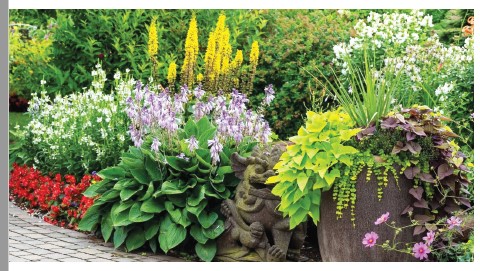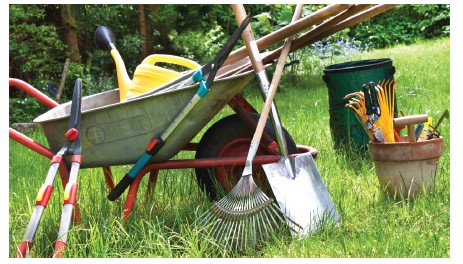Since the garden offers little activity this time of year, it is a perfect opportunity for seasoned gardeners to become reacquainted with some green-thumb basics and for potential newbies to prepare themselves for spring.
HARDINESS ZONES
In order for a plant to survive, grow, and thrive, it must be able tolerate varying conditions throughout the year including low and high temperatures and the amount and distribution of rainfall. Zone maps show where various permanent landscapes can adapt and flourish. Each hardiness zone is a geographic area defined to encompass a certain range of climate conditions relevant to plant growth and survival.
The USDA Hardiness Zone Map separates North America into eleven planting zones. Each is approximately ten degrees warmer or colder than the adjacent zon
Most of the warmer zones in the United States are found in the southern half of the country and along the southern coasts (zones 9, 10, and 11). Galveston and the upper Texas coast are classified as zone 9. In comparison, Puerto Rico has the warmest hardiness zone of 13b while Alaska has a rating down to 1.
SUNLIGHT AND SHADE
When purchasing a new plant, check each selection for tags that indicate the light requirements. Remembering that afternoon sun is hotter and stronger than morning sun is the biggest help in placing plants in the proper light.
Full sun (6+ hours a day) is specifically for high sun-tolerant plants like succulents and vegetables. Other full sun plants will thrive with somewhat less coverage.
Few aspects of gardening are more confusing than the terms ‘part sun’ and ‘part shade.’ Generally, part sun means 4-6 hours of direct sun a day, while part shade means a shorter period of sun or shelter from afternoon sun.
More specifically, part sun (4-6 hours a day) plants can bear less sunlight and will benefit from some time in the shade during the afternoon. Many flowering plants do the best in part sun, so morning exposure may be the most beneficial.
Part shade indicates the same time frame (4-6 hours a day) under cover from the sun. Plant in an east-facing area for the best utilization of afternoon shade.
Dappled sun indicates that these plants need less sun and even more protection than part shade plants. Limit them to only brief exposure to sun each day.
Lastly, full shade plants need less than two hours of direct sunlight per day. Grow these plants in the darkest parts of the yard, on a covered porch, or keep them indoors as a houseplant.
ANNUAL VS. PERENNIAL
 Both annuals and perennials deserve a place in a well-rounded garden. Annual plants usually live for one growing season, and they can be planted at any time during that season until the weather becomes too cold or too warm.
Both annuals and perennials deserve a place in a well-rounded garden. Annual plants usually live for one growing season, and they can be planted at any time during that season until the weather becomes too cold or too warm.
After the growing season, the blooms and leaves will die, and the entire plant will need to be replaced the following year. Fortunately, annuals will leave seeds that can be used for that purpose.
Some perennials may keep their leaves year-round, while others will dieback at the end of their season but return the following spring from the same root system. Perennials may have less flashy blooms and bloom for shorter periods. They are best planted in fall or spring.
Specific perennial designations have been created to help distinguish their growth patterns. Hardy perennials can survive freezing temperatures, while a tender perennial may not survive lower than 50 degrees without damage. A woody perennial will keep its stems and aboveground parts in dormancy, but herbaceous perennials die to the ground when dormant.
TOOLS
Gardening tools can be costly and can take up sorely needed space, so prevent going overboard by first determining which tools are truly essential (see list below). Purchase hand tools with brightly colored handles to make them easier to spot when dropped without becoming lost in the dirt or other greenery around your garden.
Most importantly, buying high-quality and caring for them properly can go a long way towards getting the most from your investment. Never put tools away dirty, mucky or muddy. They will benefit from a soap and water bath after each use and reward you with years of valuable service.
Garden Gloves - An indispensable item in every gardener’s inventory, they not only keep your hands and fingernails from getting dirty but also protect your hands and wrists from thorny branches, scratches, and scrapes. Gloves should be durable (but not bulky), water resistant, with long cuffs if possible. Wearing gloves also helps avoid rashes or allergic reactions to plants, fertilizers, or chemicals.
Garden Forks - Used to dig into dense soil, turn soil, and scoop mulch as well as a multitude of other tasks.
Hand Trowels - Useful for transplanting bedding plants, planting containers, and taking out weeds (a long narrow blade is good for weeding).
Loppers - Help keep hedges trimmed, remove dead branches, easily “lop” off unsightly or unwanted branches and twigs up to one or more inches in diameter. Longer loppers can handle 2-inch branches.
Water hoses - Essential unless you have an extensive watering system that covers all of the yard as well as the garden beds and container plants. Adjustable spray nozzles on your hoses allow you to mist newly planted seeds and to soak established plants that require more water in the summer heat. Vinyl hoses may be lighter in weight as well as less expensive but they tend to kink and do not last as long as the rubber hoses. Store hoses coiled up without kinks that can weaken sections.
Wheelbarrows or Garden Carts - Move trays of new seedlings, bedding plants, dirt, compost, piles of raked up leaves easily with little effort.
Pruning shears - Necessary for cutting and trimming tasks and indispensable for harvesting herbs, fruits, and vegetables. Helpful also when cutting twigs and branches for the compost pile or for disposal.
Rakes - Vital for a number of garden tasks such as clearing leaves, spreading mulch, leveling soil, and breaking up hard dirt in the spring.
 Shovels - These are extremely useful tools in the garden. There are always holes to be dug and a shovel is great for moving dirt from one area to another. Use a shovel for stirring compost, mixing potting soil, turning dirt or removing dirt (pointed shovels are best for digging).
Shovels - These are extremely useful tools in the garden. There are always holes to be dug and a shovel is great for moving dirt from one area to another. Use a shovel for stirring compost, mixing potting soil, turning dirt or removing dirt (pointed shovels are best for digging).
Garden Hoe - Can be particularly helpful when preparing a garden or beds for planting in the spring, weeding, and clearing unwanted growth as well as spreading compost and potting soil.